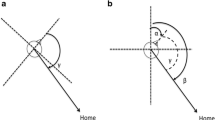Abstract
Converging lines of evidence suggest that the presence of non-target landmarks affects the performance of delayed target-directed movements (e.g., Diedrichsen et al. 2004; Sheth and Shimojo 2004). In the present experiment, we examined the effects of non-target landmarks on the accuracy and precision of delayed and immediate target-directed pointing movements. In our experiment, the landmarks were present just prior to and during the presentation of the target; they were never present during the execution of the movement. Absolute errors were significantly reduced when the landmarks were available during target presentation for both delayed and immediate action conditions. In contrast, the presence of landmarks improved the precision of delayed but not immediate movements (as indexed by the variable error). The locus of this “landmark benefit” appears to be in the encoding of target position since landmarks were never available after target offset. We suggest that, when available, information provided by landmarks is used to improve the accuracy of the estimation of target location. Since the targets were presented for only 100 ms, it is apparent that the spatial information available from landmarks can be quite rapidly used to estimate target position. Further, with respect to the precision of movements, we suggest that the presence of landmarks serves to improve the stability of the estimation of target position. This particular reliance on landmark information becomes more critical as the movement is delayed.




Similar content being viewed by others
References
Blouin J, Bard C, Teasdale N, Paillard J, Fleury M, Forget R, Lamarre Y (1993) Reference systems for coding spatial information in normal subjects and a deafferented patient. Exp Brain Res 93(2):324–331
Bridgeman B, Kirch M, Sperling A (1981) Segregation of cognitive and motor aspects of visual function using induced motion. Percept Psychophys 29(4):336–342
Bridgeman B, Peery S, Anand S (1997) Interaction of cognitive and sensorimotor maps of visual space. Percept Psychophys 59(3):456–469
Bruno N (2001) When does action resist visual illusions? Trends Cogn Sci 1;5(9):379–382
Chieffi S, Ricci M, Carlomagno S (2001) Influence of visual distractors on movement trajectory. Cortex 37(3):389–405
Coello Y, Richaud S, Magne P, Rossetti Y (2003) Vision for spatial perception and vision for action: a dissociation between the left–right and near–far dimensions. Neuropsychologia 41(5):622–633
Cohen YE, Andersen RA (2002) A common reference frame for movement plans in the posterior parietal cortex. Nat Rev Neurosci 3(7):553–562
Diedrichsen J, Werner S, Schmidt T, Trommershauser J (2004) Immediate spatial distortions of pointing movements induced by visual landmarks. Percept Psychophys 66(1):89–103
Fisk JD, Goodale MA (1985) The organization of eye and limb movements during unrestricted reaching to targets in contralateral and ipsilateral visual space. Exp Brain Res 60(1):159–178
Gentilucci M, Negrotti A (1994) Dissociation between perception and visuomotor transformation during reproduction of remembered distances. J Neurophysiol 72(4):2026–2030
Gentilucci M, Chieffi S, Deprati E, Saetti MC, Toni I (1996) Visual illusion and action. Neuropsychologia. 34(5):369–376
Goodale MA, Milner AD (1992) Separate visual pathways for perception and action.Trends Neurosci 15(1):20–25
Goodale MA, Pelisson D, Prablanc C (1986) Large adjustments in visually guided reaching do not depend on vision of the hand or perception of target displacement. Nature 24–30;320(6064):748–750
Goodale MA, Westwood DA, Milner AD (2004) Two distinct modes of control for object-directed action. Prog Brain Res 144:131–144
Haffenden AM, Goodale MA (2000) Independent effects of pictorial displays on perception and action.Vis Res 40(10–12):1597–1607
Hu Y, Goodale MA (2000) Grasping after a delay shifts size-scaling from absolute to relative metrics. J Cogn Neurosci 12(5):856–868
Krigolson O, Heath M (2004) Background visual cues and memory-guided reaching. Hum Mov Sci 23(6):861–877
Lemay M, Bertram CP, Stelmach GE (2004) Pointing to an allocentric and egocentric remembered target. Motor Control 8(1):16–32
Milner AD, Goodale MA (1995) The visual brain in action. Oxford University Press, Oxford
Neggers SF, Bekkering H (2000) Ocular gaze is anchored to the target of an ongoing pointing movement. J Neurophysiol 83(2):639–651
Prablanc C, Echallier JF, Komilis E, Jeannerod M (1979) Optimal response of eye and hand motor systems in pointing at a visual target. I. Spatio-temporal characteristics of eye and hand movements and their relationships when varying the amount of visual information. Biol Cybern 35(2):113–124
Pratt J, Abrams RA (1994) Action-centered inhibition—effects of distractors on movement planning and execution. Hum Mov Sci 13(2):245–254
Rossetti Y (1998) Implicit short-lived motor representations of space in brain damaged and healthy subjects. Conscious Cogn 7(3):520–558
Schindler I, Rice NJ, McIntosh RD, Rossetti Y, Vighetto A, Milner AD (2004) Automatic avoidance of obstacles is a dorsal stream function: evidence from optic ataxia. Nat Neurosci 7(7):779–784
Sheth BR, Shimojo S (2004) Extrinsic cues suppress the encoding of intrinsic cues. J Cogn Neurosci 16(2):339–350
Tipper SP, Lortie C, Baylis GC (1992) Selective reaching—evidence for action-centered attention. J Exp Psychol Hum Percep Perform 18(4):891–905
Toni I, Gentilucci M, Jeannerod M, Decety J (1996) Differential influence of the visual framework on end point accuracy and trajectory specification of arm movements. Exp Brain Res 111(3):447–454
Westwood DA, Goodale MA (2003) Perceptual illusion and the real-time control of action. Spat Vis 16(3–4):243–254
Wong E, Mack A (1981) Saccadic programming and perceived location. Acta Psychol 48(1–3):123–131
Acknowledgements
This research was supported by grants to MAG from the Natural Sciences and Engineering Research Council of Canada and the Canada Research Chairs Program. The authors would like to thank Elizabeth Wilson for assistance in data collection and Haitao Yang for technical support.
Author information
Authors and Affiliations
Corresponding author
Rights and permissions
About this article
Cite this article
Obhi, S.S., Goodale, M.A. The effects of landmarks on the performance of delayed and real-time pointing movements. Exp Brain Res 167, 335–344 (2005). https://doi.org/10.1007/s00221-005-0055-5
Received:
Accepted:
Published:
Issue Date:
DOI: https://doi.org/10.1007/s00221-005-0055-5




